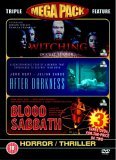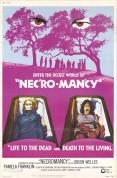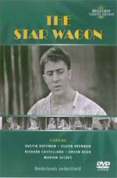![Being John Malkovich [DVD]](/pictures/1139321.jpg) Being John Malkovich | DVD | (14/03/2016)
from £20.23
| Saving you £-5.24 (N/A%)
| RRP
Being John Malkovich | DVD | (14/03/2016)
from £20.23
| Saving you £-5.24 (N/A%)
| RRP ![Frank McKlusky [2002]](/pictures/1014234.jpg) Frank McKlusky | DVD | (04/10/2004)
from £4.98
| Saving you £10.01 (201.00%)
| RRP
Frank McKlusky | DVD | (04/10/2004)
from £4.98
| Saving you £10.01 (201.00%)
| RRP As a child Frank McKlusky (Sheridan) watched his daredevil father ""Madman"" McKlusky become comatose in an ill-fated motorcycle stunt. Now as a risk-avoiding adult he lives with his parents always wears protective gear and works by the Claims Investigator handbook. Insurance fraud wiped out the family finances but Frank's career compensates. When he suspiciously loses his partner on the job Frank must become a master of disguise take on a sexy new partner and grab evidence to bus
![The Stranger [1946]](/pictures/1012865.jpg) The Stranger | DVD | (18/03/2002)
from £N/A
| Saving you £N/A (N/A%)
| RRP
The Stranger | DVD | (18/03/2002)
from £N/A
| Saving you £N/A (N/A%)
| RRP The Stranger, according to Orson Welles, "is the worst of my films. There is nothing of me in that picture. I did it to prove that I could put out a movie as well as anyone else." True, set beside Citizen Kane, Touch of Evil, or even The Trial, The Stranger is as close to production-line stuff as the great Orson ever came. But even on autopilot Welles still leaves most filmmakers standing. The shadow of the Second World War hangs heavy over the plot. A war crimes investigator, played by Edward G Robinson, tracks down a senior Nazi, Franz Kindler, to a sleepy New England town where he's living in concealment as a respected college professor. The script, credited to Anthony Veiller but with uncredited input from Welles and John Huston, is riddled with implausibilities: we're asked to believe, for a start, that there'd be no extant photos of a top Nazi leader. The casting's badly skewed, too. Welles wanted Agnes Moorehead as the investigator and Robinson as Kindler, but his producer, Sam Spiegel, wouldn't wear it. So Welles himself plays the supposedly cautious and self-effacing fugitive--and if there was one thing Welles could never play, it was unobtrusive. What's more, Spiegel chopped out most of the two opening reels set in South America, in Welles' view, "the best stuff in the picture". Still, the film's far from a write-off. Welles' eye for stunning visuals rarely deserted him and, aided by Russell Metty's skewed, shadowy photography, The Stranger builds to a doomy grand guignol climax in a clock tower that Hitchcock must surely have recalled when he made Vertigo. And Robinson, dogged in pursuit, is as quietly excellent as ever. On the DVD: not much in the way of extras, except a waffly full-length commentary from Russell Cawthorne that tells us about the history of clock-making and where Edward G was buried, but precious little about the making of the film. Print and sound are acceptable, but though remastering is claimed, there's little evidence of it. --Philip Kemp
![Jane Eyre [DVD] [1944]](/pictures/1100196.jpg) Jane Eyre | DVD | (11/11/2011)
from £N/A
| Saving you £N/A (N/A%)
| RRP
Jane Eyre | DVD | (11/11/2011)
from £N/A
| Saving you £N/A (N/A%)
| RRP This 1943 version of Charlotte Brontë's Jane Eyre was made just two years after Citizen Kane, and it certainly looks like star Orson Welles muscled his way behind the camera much of the time. (In fact, co-star Joan Fontaine--who plays the title character--has maintained that Welles methodically did just that every day on the set.) Not that the film's official director was a hack: Robert Stevenson gets the credit, a man who later had a busy career at Disney making numerous live-action hits such as Mary Poppins. But there's no mistaking Welles' masterful hand in this film's bold and creative look, and there's no getting away from his enigmatic charisma as Rochester, the widower who takes in Jane as a governess to his daughter. An engrossing, gorgeous film, there's even a small role for Elizabeth Taylor at the beginning as Jane's unlucky, doomed friend at a cruel boarding school. --Tom Keogh, Amazon.com
![Edward G. Robinson - Scarlet Street / The Stranger [1946]](/pictures/1012864.jpg) Edward G. Robinson - Scarlet Street / The Stranger | DVD | (18/03/2002)
from £N/A
| Saving you £N/A (N/A%)
| RRP
Edward G. Robinson - Scarlet Street / The Stranger | DVD | (18/03/2002)
from £N/A
| Saving you £N/A (N/A%)
| RRP In a way, Scarlet Street is a remake. It's taken from a French novel, La Chienne (literally, "The Bitch") that was first filmed by Jean Renoir in 1931. Renoir brought to the sordid tale all the colour and vitality of Montmartre; Fritz Lang's version shows us a far harsher and bleaker world. The film replays the triangle set-up from Lang's previous picture, The Woman in the Window, with the same three actors. Once again, Edward G Robinson plays a respectable middle-aged citizen snared by the charms of Joan Bennett's streetwalker, with Dan Duryea as her low-life pimp. The plot closes around the three of them like a steel trap. This is Lang at his most dispassionate. Scarlet Street is a tour de force of noir filmmaking, brilliant but ice-cold. The Stranger, according to Orson Welles, "is the worst of my films. There is nothing of me in that picture". But even on autopilot Welles still leaves most filmmakers standing. A war crimes investigator, played by Edward G Robinson, tracks down a senior Nazi to a sleepy New England town where he's living in concealment as a respected college professor. Welles wanted Agnes Moorehead as the investigator and Robinson as the Nazi Franz Kindler, but his producer, Sam Spiegel, wouldn't wear it. So Welles himself plays the supposedly cautious and self-effacing fugitive--and if there was one thing Welles could never play, it was unobtrusive. Still, the film's far from a write-off. Welles' eye for stunning visuals rarely deserted him and, aided by Russell Metty's skewed, shadowy photography, The Stranger builds to a doomy grand guignol climax in a clocktower that Hitchcock must surely have recalled when he made Vertigo. And Robinson, dogged in pursuit, is as quietly excellent as ever. On the DVD: sparse pickings. Both films have a full-length commentary by Russell Cawthorne which adds the occasional insight, but is repetitive and not always reliable. The box claims both print have been "fully restored and digitally remastered", but you'd never guess. --Philip Kemp
 The Witching / After Darkness / Blood Sabbath | DVD | (06/05/2006)
from £N/A
| Saving you £N/A (N/A%)
| RRP
The Witching / After Darkness / Blood Sabbath | DVD | (06/05/2006)
from £N/A
| Saving you £N/A (N/A%)
| RRP The Withcing: A strange and sinister man Mr Cato (Orson Welles) wields extraordinary power in the small town of Lilith. Almost supernatural power. The townsfolk indulge in weird ritual in their pursuit of necromancy... bringing the dead back to life. Against this disturbing background it is a young beautiful girl Lori (Pamela Franklin) who becomes the human catalyst between life and death... After Darkness: Lawrence Hunningford (Julian Sands) becomes insane when as a child he witnesses the tragic drowning of his twin brother in the sands. He becomes gradually schizophrenic and is committed to the clinic. His elder brother Peter (John Hurt) accepts an invitation to teach at the University near the clinic. After Lawrence attempts to end his life Peter discharges his brother from the clinic and moves with him into a huge run down apartment and commits to take care of his brother. But the strain begins to show as more and more he neglects his family and work. Pascale (Victoria Abril) Peter's young assistant at the University worries about the strange changes she noticed in him. She follows him to his apartment and encounters Lawrence. Not suspecting anything and in spite of Peter's violent jealousy she interferes in the brother's relationship by answering Lawrence's desires. But more and more Lawrence's illness spreads to Peter whose jealousy and eventual madness end in tragedy and Lawrence is freed from his darkness. Blood Sabbath: When travelling through the woods young David is captured by a members of a witches' coven. Soon he is involved in a bizarre power struggle with a beautiful witch and the coven's evil queen...
 Necromancy | DVD | (21/04/2008)
from £N/A
| Saving you £N/A (N/A%)
| RRP
Necromancy | DVD | (21/04/2008)
from £N/A
| Saving you £N/A (N/A%)
| RRP Orson Welles plays the head of a witches' coven in the town of Lilith.
![Confidential Report [1955]](/pictures/1071490.jpg) Confidential Report | DVD | (02/04/2007)
from £9.43
| Saving you £-3.44 (-57.40%)
| RRP
Confidential Report | DVD | (02/04/2007)
from £9.43
| Saving you £-3.44 (-57.40%)
| RRP Guy Van Stratten a convicted American smuggler leaves an Italian prison term with one asset a dying man's words about the wealthy mysterious and elusive Gregory Arkadin. Guy sets out in search of the enigmatic Arkadin and starts to scrutinize him through his lovely daughter Raina. To thwart Van Stratten's investigation Arkadin claims amnesia about his early life and sends Guy off to investigate his ""unknown"" past. Guy's quest spans many continents and unearths eccentric characters who contribute information about the shadowy Arkadin. But the real purpose of Guy's assignment proves deadly - can he survive it? Orson Welles wrote directed and co-starred in this stylish serpentine mystery that carries echoes of his masterpiece 'Citizen Kane'.
![Stranger, The / Orson Welles On Film [1946]](/pictures/1023092.jpg) Stranger, The / Orson Welles On Film | DVD | (01/11/2000)
from £7.54
| Saving you £-3.55 (N/A%)
| RRP
Stranger, The / Orson Welles On Film | DVD | (01/11/2000)
from £7.54
| Saving you £-3.55 (N/A%)
| RRP The Stranger, according to Orson Welles, "is the worst of my films. There is nothing of me in that picture. I did it to prove that I could put out a movie as well as anyone else." True, set beside Citizen Kane, Touch of Evil, or even The Trial, The Stranger is as close to production-line stuff as the great Orson ever came. But even on autopilot Welles still leaves most filmmakers standing. The shadow of the Second World War hangs heavy over the plot. A war crimes investigator, played by Edward G Robinson, tracks down a senior Nazi, Franz Kindler, to a sleepy New England town where he's living in concealment as a respected college professor. The script, credited to Anthony Veiller but with uncredited input from Welles and John Huston, is riddled with implausibilities: we're asked to believe, for a start, that there'd be no extant photos of a top Nazi leader. The casting's badly skewed, too. Welles wanted Agnes Moorehead as the investigator and Robinson as Kindler, but his producer, Sam Spiegel, wouldn't wear it. So Welles himself plays the supposedly cautious and self-effacing fugitive--and if there was one thing Welles could never play, it was unobtrusive. What's more, Spiegel chopped out most of the two opening reels set in South America, in Welles' view, "the best stuff in the picture". Still, the film's far from a write-off. Welles' eye for stunning visuals rarely deserted him and, aided by Russell Metty's skewed, shadowy photography, The Stranger builds to a doomy grand guignol climax in a clock tower that Hitchcock must surely have recalled when he made Vertigo. And Robinson, dogged in pursuit, is as quietly excellent as ever. On the DVD: not much in the way of extras, except a waffly full-length commentary from Russell Cawthorne that tells us about the history of clock-making and where Edward G was buried, but precious little about the making of the film. Print and sound are acceptable, but though remastering is claimed, there's little evidence of it. --Philip Kemp
 The Simon Wiesenthal Collection | DVD | (11/03/2008)
from £12.13
| Saving you £7.86 (64.80%)
| RRP
The Simon Wiesenthal Collection | DVD | (11/03/2008)
from £12.13
| Saving you £7.86 (64.80%)
| RRP Genocide: The winner of the 1981 Oscar for Best Documentary Genocide tells the story of the millions of men women and children who fell victim to Hitler's Final Solution. Using archival film footage and compelling still photography this extraordinary documentary traces the evolution of the Holocaust in fascinating and horrifying detail and chronicles the scourge of anti-Semitism from Biblical times to the rise of Nazism. The heart of this film is the moving narrative of ordinary people caught up in the Nazi reign of terror. Their individual stories of suffering and heroism challenge the viewer - to see the victims as beings and to remember... The Long Way Home: The film examines the critical post World War II period from 1945 - 1948 and the plight of tens of thousands of refugees who survived the Nazi Holocaust and their often-illegal attempts to get to the Jewish homeland. It explores how much of the world turned its back on the tragedy of these forgotten people and the world events that led to the creation of the state of Israel. Liberation: Liberation tells the dramatic story of the battle waged on two fronts during World War II - the allied campaign to liberate Europe and Hitler's genocidal war against the Jews. Using archival footage contemporary radio broadcasts and enthralling first person accounts Liberation recreates the heady atmosphere of Europe emerging from Nazi domination - in stark contrast to the horrific final days of the Final Solution. Liberation begins in 1942 when the struggling Allies began envisioning an invasion of Europe. The film reveals the strategies and deceptions on all sides while vividly depicting the struggle on the battlefield. But most of all this film documents the compelling stories of the Jews of Europe - their tragedy courage resistance and survival.
![The Stranger [1946]](/pictures/1082763.jpg) The Stranger | DVD | (19/05/2008)
from £N/A
| Saving you £N/A (N/A%)
| RRP
The Stranger | DVD | (19/05/2008)
from £N/A
| Saving you £N/A (N/A%)
| RRP The Most Deceitful Man A Woman Ever Loved! Welles stars as college professor Charles Rankin who is living a quiet life in a small Connecticut town with his lovely wife Mary. The arrival of jumpy German fellow Meineke leaves Rankin disturbed and his quiet life is destroyed as he must go to deadly measures to stop Meineke revealing his dark secret.
![The Stranger [1946]](/pictures/1013342.jpg) The Stranger | DVD | (18/10/1999)
from £4.99
| Saving you £8.00 (160.32%)
| RRP
The Stranger | DVD | (18/10/1999)
from £4.99
| Saving you £8.00 (160.32%)
| RRP The legendary story that hovers over Orson Welles' The Stranger is that he wanted Agnes Moorehead to star as the dogged Nazi hunter who trails a war criminal to a sleepy New England town. The part went to Edward G. Robinson, who is marvellous, but it points out how many compromises Welles made on the film in an attempt to show Hollywood he could make a film on time, on budget and on their own terms. He accomplished all three, turning out a stylish if unambitious film noir thriller, his only Hollywood film to turn a profit on its original release. Welles stars as unreformed fascist Franz Kindler, hiding as a schoolteacher in a New England prep school for boys and newly married to the headmaster's lovely if naive daughter (Loretta Young). Welles, the director, is in fine form for the opening sequences, casting a moody tension as agents shadow a twitchy low-level Nazi official skulking through South American ports and building up to dramatic crescendo as Kindler murders this little man, the lovely woods becoming a maelstrom of swirling leaves that expose the body he furiously tries to bury. The rest of the film is a well designed but conventional cat-and-mouse game featuring an eye-rolling performance by Welles and a thrilling conclusion played out in the dark clock tower that looms over the little village. --Sean Axmaker
![Journey In To Fear [DVD]](/pictures/1104525.jpg) Journey In To Fear | DVD | (28/02/2011)
from £N/A
| Saving you £N/A (N/A%)
| RRP
Journey In To Fear | DVD | (28/02/2011)
from £N/A
| Saving you £N/A (N/A%)
| RRP ![Orson Welles - Double Feature 1 [1953]](/pictures/1046368.jpg) Orson Welles - Double Feature 1 | DVD | (10/04/2006)
from £N/A
| Saving you £N/A (N/A%)
| RRP
Orson Welles - Double Feature 1 | DVD | (10/04/2006)
from £N/A
| Saving you £N/A (N/A%)
| RRP The Stranger: In postwar Germany a meeting of the War Crimes Commission is being held. Those present decide that a heinous Nazi war criminal (Konstantin Shayne) should be released from prison in the hopes that he will lead the commission to his superior the infamous Franz Kindler (Orson Welles) one of the architects of the genocide against the Jews. A federal agent (Edward G. Robinson) is assigned to follow Shayne and the chase begins. This exciting thriller from Orson Welles moves to the town of Harper Connecticut where the Nazi Kindler is living under an assumed name... King Lear: Orson Welles stars in the title role in this made-for-television production of the Shakespearean tragedy about an aging king betrayed by his daughters.
 The Star Wagon | DVD | (01/11/2004)
from £N/A
| Saving you £N/A (N/A%)
| RRP
The Star Wagon | DVD | (01/11/2004)
from £N/A
| Saving you £N/A (N/A%)
| RRP Dustin Hoffman stars in this stage adaptation of the Maxwell Anderson play.
![Confidential Report [1955]](/pictures/1012317.jpg) Confidential Report | DVD | (28/01/2002)
from £14.99
| Saving you £-9.00 (N/A%)
| RRP
Confidential Report | DVD | (28/01/2002)
from £14.99
| Saving you £-9.00 (N/A%)
| RRP  The Best Of Film Noir | DVD | (27/10/2003)
from £N/A
| Saving you £N/A (N/A%)
| RRP
The Best Of Film Noir | DVD | (27/10/2003)
from £N/A
| Saving you £N/A (N/A%)
| RRP Film Noir is Hollywoods truly original vision for the shadowy smoky underworld. In films from the 40's and 50's they entertain us with intrigue conflict and lust. The Best Of Film Noir takes you to that other side of life which only a movie can - the Hollywood of not only yesteryear but of today as well.
![Citizen Kane [1941]](/pictures/1012123.jpg) Citizen Kane | DVD | (08/12/2003)
from £N/A
| Saving you £N/A (N/A%)
| RRP
Citizen Kane | DVD | (08/12/2003)
from £N/A
| Saving you £N/A (N/A%)
| RRP In May of 1941 RKO Radio Pictures released a controversial film by a 25-year-old first-time director. That premier of Orson Welles' 'Citizen Kane' was to have a profound and lasting effect of the art of motion pictures. It has been hailed as the best American film ever made and it's as powerful a film today as it was fifty years ago. It earned eight Academy Award nominations and won the Oscar for Best Screenplay. Through its unique jigsaw-puzzle storyline inventive cinematography brilliant ensemble acting and direction by Welles the story of Charles Foster Kane is a fascinating portrait of America's love of power and materialism and the corruption it sometimes fosters. Like all great films Citizen Kane is a memorable fusion of cinematic art and marvellous entertainment.
![The Stranger [1946]](/pictures/1012150.jpg) The Stranger | DVD | (17/11/2003)
from £N/A
| Saving you £N/A (N/A%)
| RRP
The Stranger | DVD | (17/11/2003)
from £N/A
| Saving you £N/A (N/A%)
| RRP The Stranger, according to Orson Welles, "is the worst of my films. There is nothing of me in that picture. I did it to prove that I could put out a movie as well as anyone else." True, set beside Citizen Kane, Touch of Evil, or even The Trial, The Stranger is as close to production-line stuff as the great Orson ever came. But even on autopilot Welles still leaves most filmmakers standing. The shadow of the Second World War hangs heavy over the plot. A war crimes investigator, played by Edward G Robinson, tracks down a senior Nazi, Franz Kindler, to a sleepy New England town where he's living in concealment as a respected college professor. The script, credited to Anthony Veiller but with uncredited input from Welles and John Huston, is riddled with implausibilities: we're asked to believe, for a start, that there'd be no extant photos of a top Nazi leader. The casting's badly skewed, too. Welles wanted Agnes Moorehead as the investigator and Robinson as Kindler, but his producer, Sam Spiegel, wouldn't wear it. So Welles himself plays the supposedly cautious and self-effacing fugitive--and if there was one thing Welles could never play, it was unobtrusive. What's more, Spiegel chopped out most of the two opening reels set in South America, in Welles' view, "the best stuff in the picture". Still, the film's far from a write-off. Welles' eye for stunning visuals rarely deserted him and, aided by Russell Metty's skewed, shadowy photography, The Stranger builds to a doomy grand guignol climax in a clock tower that Hitchcock must surely have recalled when he made Vertigo. And Robinson, dogged in pursuit, is as quietly excellent as ever. On the DVD: not much in the way of extras, except a waffly full-length commentary from Russell Cawthorne that tells us about the history of clock-making and where Edward G was buried, but precious little about the making of the film. Print and sound are acceptable, but though remastering is claimed, there's little evidence of it. --Philip Kemp
 Simon Wiesenthal | DVD | (19/11/2007)
from £55.33
| Saving you £19.66 (35.53%)
| RRP
Simon Wiesenthal | DVD | (19/11/2007)
from £55.33
| Saving you £19.66 (35.53%)
| RRP The Collection of 8 Simon Wiesenthal DVD's including Genocide and The Long Way Home both of which are Oscar Winners for Best Documentariy Features.

Please wait. Loading...
This site uses cookies.
More details in our privacy policy